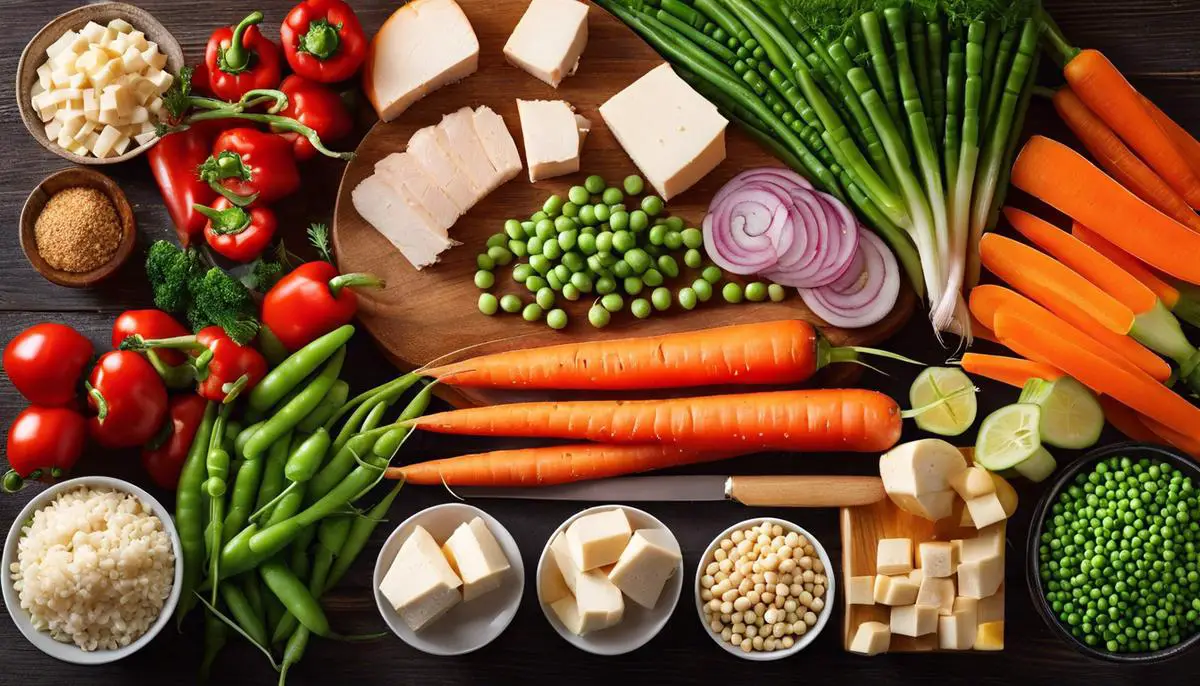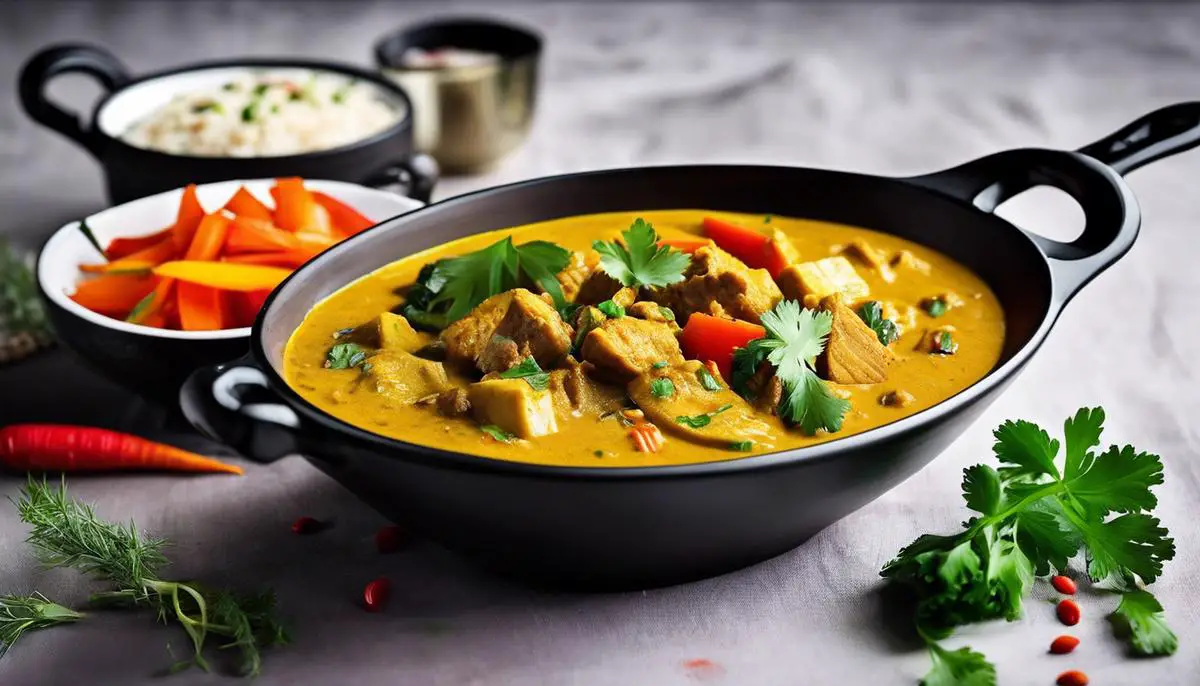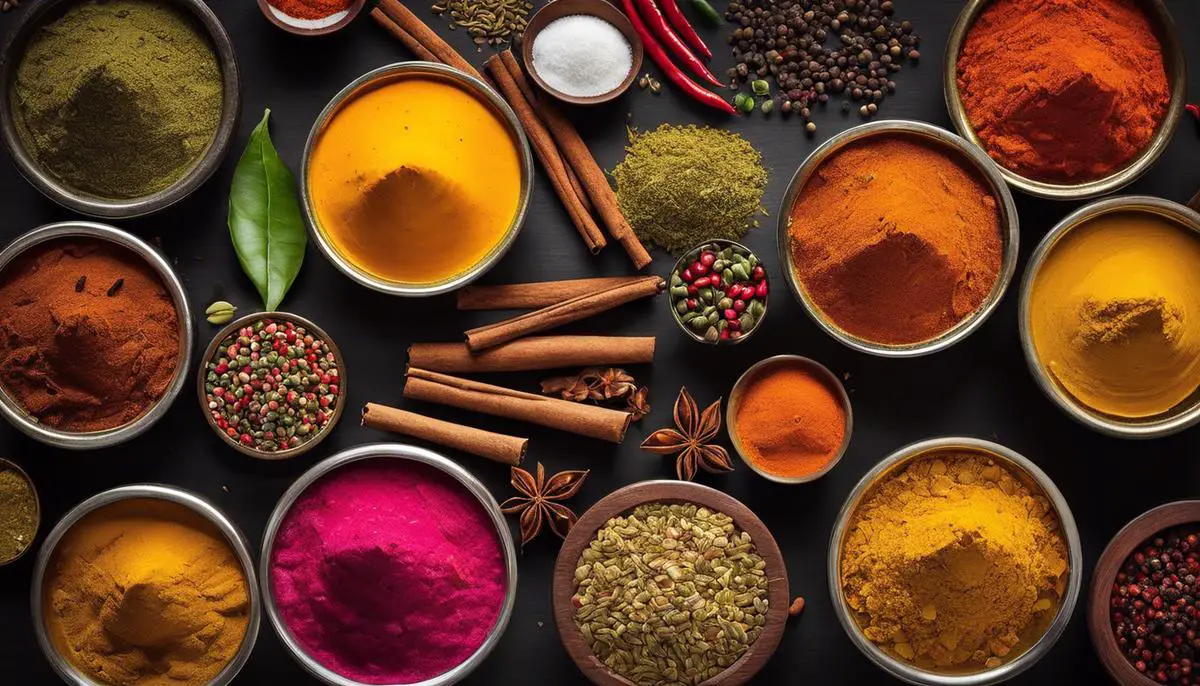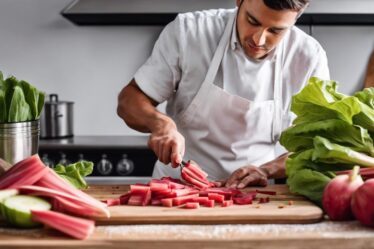
Creamy Coconut Dream: Whip Up This Easy Korma Recipe in Minutes
Korma, a rich and creamy delicacy hailing from the Indian subcontinent, captivates the senses with its complexity of flavors and aromas. This dish, though rooted in tradition, finds new life and accessibility through the incorporation of coconut milk, a delightful twist appealing to the modern palate.
Venturing into the culinary world of korma with coconut milk begins with sourcing the freshest vegetables—carrots, peas, bell peppers—and choosing the perfect protein accompaniment, be it succulent pieces of chicken or a hearty block of tofu. By cutting these ingredients into uniform, bite-sized portions, we set the stage for a symphony of flavors to unfold within each morsel. Ready to embark on this journey, we’ll first explore the art of crafting the quintessential korma paste—a blend that forms the aromatic cornerstone of our dish.
Preparing Ingredients
Crafting a Flavorful Korma: Prepping Veggies & Protein Like a Pro
Fellow culinary adventurers, there’s nothing quite as soul-stirring as the symphony of spices dancing in a perfectly concocted korma. This regal dish, hailing from the palatial kitchens of Mughal India, has made its mark on the foodie map, tempting palates with its creamy, aromatic sauce and tender morsels. To make a korma that truly sings, every slice and simmer matters—let’s dive into the delightful journey of prepping vegetables and proteins for this exquisite dish.
First off, choosing fresh and high-quality veggies is paramount. Whether you’re navigating through the bustling aisles of a farmers’ market or perusing the fresh section at your local store, keep an eye out for vibrant and firm vegetables such as carrots, peas, bell peppers, and potatoes. Each of these will add a unique texture and subtle sweetness that complements the richness of the korma sauce.
Once your vegetables are ready for their culinary fate, precision in cutting is key. Cube the potatoes and carrots uniformly for even cooking, ensuring each bite is as tender as the next. Bell peppers should be julienned, adding a slightly crisp contrast to the creamy sauce, while peas can be left whole to burst with freshness in every spoonful.
Proteins, be it succulent chicken, tender lamb, or firm tofu for the plant-based palate, require thoughtful preparation. The protein must be tender enough to absorb the korma’s depth of flavor but hold its own in texture. If opting for chicken or lamb, trimming away excess fat and cutting into bite-sized cubes will allow the myriad of spices to permeate through.
The magic happens once it’s time to marinate. Yogurt is not merely a condiment here; it is the alchemist turning your protein golden. Full-fat yogurt subtly tenderizes and envelops the protein in its tangy embrace, setting the stage for the spices. Generously blend in ground turmeric, cumin, coriander, garam masala, and a hint of chili powder. For those who walk fearlessly in the world of heat, a dash of cayenne pepper will add that fiery kick. The harmonious melange of spices should be rubbed onto the protein, which then needs to be left to marinate—a brief pause in the refrigerator for at least an hour, or ideally overnight, for flavors to marry and deepen will suffice.
As for the veggies, a quick blanch in salted boiling water works wonders for root vegetables like potatoes and carrots, ensuring they’re part-cooked and ready to soak up the flavors of the korma. The trick is not to overcook them here; they’ll do the rest of their softening in the simmering sauce.
Finally, when the symphony of prepped ingredients comes together in the pot with aromatics like ginger, garlic, and onion, the sensory celebration begins. Slow cooking allows every chunk of veggie and protein to become tender and flavorful, truly capturing the essence of this noble dish.
Remember, patience is the secret ingredient. With each stir, await the transcendent moment when the korma’s rich aroma fills the air, promising a meal that will be savored and shared with joy. Bon appétit, or as they say in the land where korma is king, ‘bismillah’—in the name of all things flavorsome and divine.

Making the Korma Paste
Roll up those sleeves, culinary comrades, and let’s dive into the aromatic world of spices imperative for crafting an authentic korma paste that’ll transform any dish into an exotic masterpiece. This thick, rich, and utterly indulgent sauce is nothing short of a flavor Odyssey, and the secret lies in the symphony of spices carefully selected for their melody of taste and fragrance.
First and foremost, cumin seeds are where the magic commences. These tiny bundles of earthy goodness add a warm and slightly bitter flavor that is fundamental to the base note of your korma. Toast these treasures gently to release their oils and full-bodied aroma before grinding them into fine submission.
Next, coriander seeds join the ensemble. These golden pearls are a citrusy delight, offering a tart, floral overtone that kisses the palate with every spoonful. Coriander seeds are not just a garnish or afterthought; they’re the harmonizing agent in our korma composition.
One cannot speak of korma without paying homage to cardamom. This queen of spices provides an intoxicating, aromatic zing. Whether you opt for the green or the black variety, cardamom brightens and elevates the flavors around it with its eucalyptus-like coolness and subtle sweetness.
The korma symphony would hit a sour note without the deep, musky undertones of cinnamon sticks. This sweet and woody bark infuses the korma with hints of warm, spicy sugariness, balancing the more pungent players that follow.
Enter the mighty cloves – tiny but fierce. Cloves possess a potent, pungent presence, so a little goes a long way. Their intensely aromatic and sweet flavors are essential for the depth and complexity in our korma paste.
Turmeric, bright as the morning sun, brings its earthy bitterness and vibrant color to the mix. Its medicinal reputation is matched only by the culinary zest it imparts. This golden spice not only adds a visual pop but also contributes a grounded, peppery base to our korma recipe.
We can’t overlook the need for some heat to cut through the richness, and that’s where red chili powder steps in. This spice ranges from mild to fiery, and the choice rests with you, my spice-loving friend, on how much kick to lend to your korma.
Lasty, nutmeg and mace, the fraternal twins of the spice world, offer a piquant sweetness with their lovely, woody aromas. These often-overlooked spices add a layer of depth to the flavor profile that can elevate a good korma to greatness.
In the dance of the korma spices, each has its steps to follow, its moment to shine. When blended together with a foundation of aromatic garlic, onions, and ginger, this spice paste will be the soul of your korma, heightening the subtlety of your carefully marinated proteins and tenderly blanched vegetables. Breathe in the heady scent as the paste cooks down, noting the mellowing of sharp edges into smooth, creamy richness. Embrace the alchemy of slow cooking, where patience is rewarded with layers upon layers of flavors so intricately woven together that each bite is a melody on the tongue.
Now, go forth and wield these spices with the confidence of a seasoned chef. The crafting of a true korma is but a handful of spices away—the rest is culinary artistry waiting to unfold beneath your fingertips.

Cooking and Simmering
Once your proteins have been marinated to perfection, and your vegetables blanched just to that toothsome bite, it’s time to dive into the broth of the matter—the liquid gold that transforms a korma from simply good to irresistibly divine.
Begin by heating a generous dollop of ghee or oil in a pot or deep skillet. If your kitchen doesn’t waft with the rich aroma of this golden lubricant, are you even cooking a korma? Once the ghee shimmers with excitement, toss in a bay leaf or two for that subtle depth of flavor, followed immediately by whole spices—cumin, coriander seeds, cardamom, cinnamon sticks, and cloves. As they sizzle and pop, you’ll know they’re ready to embrace the next wave of flavors.
Next, add the finely chopped onions, and let them sweat it out. The key is to cook them until they are golden and caramelized, a step that cannot be rushed. These onions will lay down the sweet, savory foundation crucial for a robust korma base. Now introduce garlic and ginger, creating that harmonious buzz which can only be achieved by their fresh, pungent profiles colliding with the sweetness of onions.
At this stage, it’s time for the powdered dance — turmeric, chili powder, nutmeg, and a touch of mace. Let them pirouette in the oil, gleefully coating the onions. This is essential for layering. These spices should be cooked just enough to release their oils, but be vigilant! There is a fine line between perfectly releasing flavors and burning.
Pour in pureed tomatoes, if that’s your style, and simmer till oil gleams on the surface—a luscious sheen, signaling it’s time for the protein to join the party. Nestle those marinated morsels into their savory bath, coating them lovingly with the masala. Now, the patience instilled earlier comes back into play. Cover and let it simmer. This low-and-slow conversation between the spices and the proteins is where magic happens.
At this juncture, a true korma whisperer introduces yogurt or heavy cream, stirred gently, serenading richness into every corner of the concoction. For those seeking a nuttier essence, ground cashew paste or almond meal can take your korma to nutopia. The sauce must lovingly cling to the back of a spoon, signaling readiness for the final flourish—a handful of freshly chopped cilantro or a pinch of garam masala.
A perfectly simmered korma is a ballet of spices, a slow seduction of ingredients coming together to create a love story on a plate. Dive in with some naan or rice alongside, and revel in the joy that only a carefully crafted korma can bring to your table.
Remember, a korma is not simply a dish, it’s an experience—a testament to the culinary artistry that exists in the delicate balance of spice, patience, and passion.

Having journeyed through the meticulous process of creating a korma with coconut milk, we have not only combined ingredients but also woven together a tapestry of flavors, each thread essential to the vivid pattern of the finished dish. The alchemy of spices, the tenderness of the protein, and the lush, rich embrace of coconut milk culminates in more than just a meal—it’s an experience, a celebration of culinary harmony. As the final simmer fades and the scent wafts through the kitchen, it becomes clear that what started as a simple compilation of ingredients has transformed into a deeply satisfying and nourishing feast, a testament to the timeless art of cooking.



